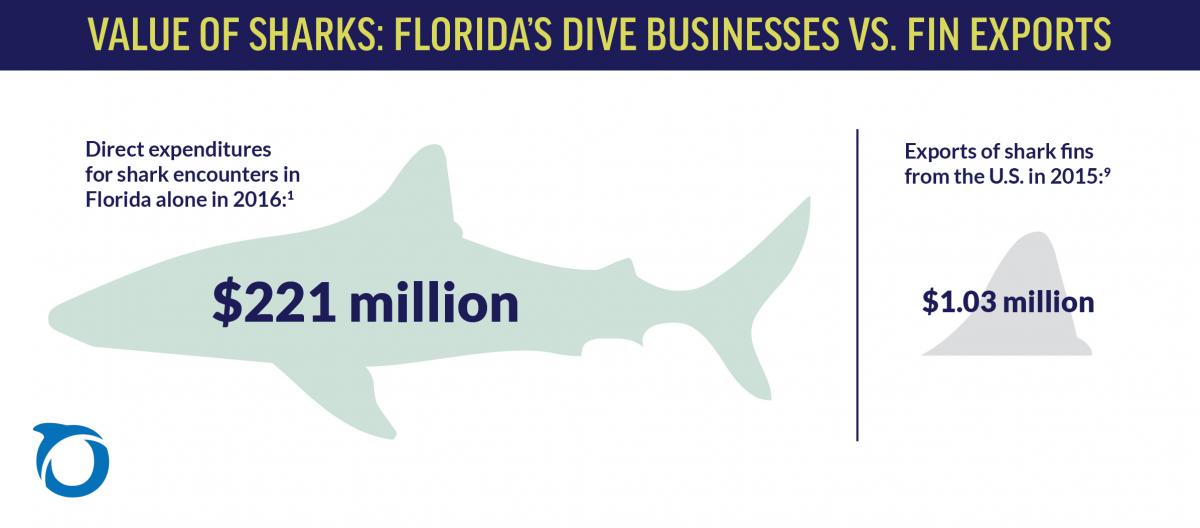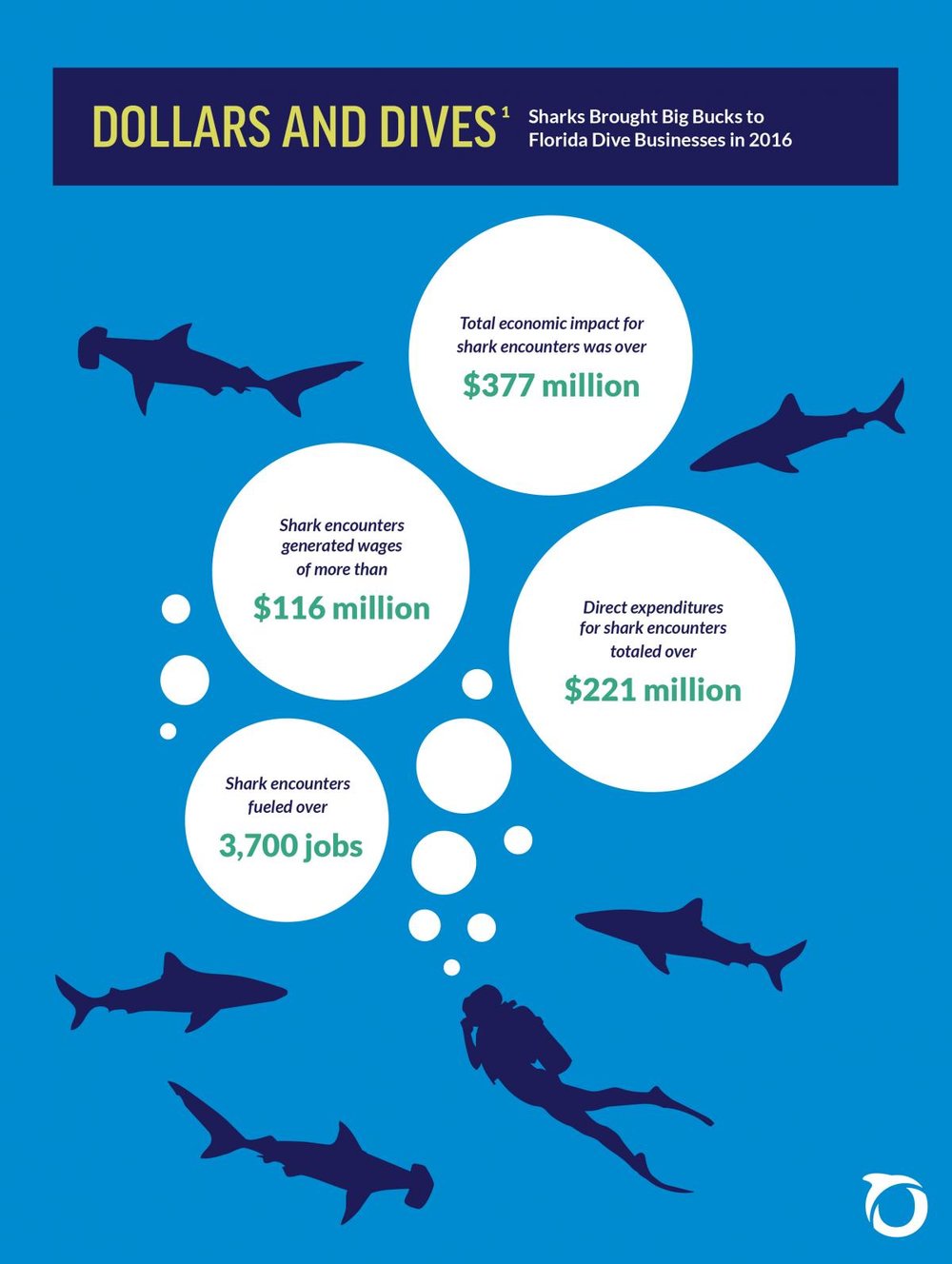Sharks Make a Big Impact for Florida's Economy
SHARK TOURISM IS A RENEWABLE RESOURCE
Income from dive tourism is far greater than that of shark fishing. It is a renewable resource that can continue for many years to come, as long as you have abundant reef and marine life. Nature-based tourism is one of the fastest growing sectors of the tourism industry. And divers are especially keen to see sharks. Sharks are not only important to maintain healthy reef and fish populations, they also benefit the economy. A live shark is worth far more than a dead shark that gets sold for meat or fins. Shark diving and watching can provide jobs for non-skilled workers. This income and employment in turn (indirectly and directly) stimulates local economies through an increased demand for transportation, lodging, food, nature interpretation, not to mention, even souvenirs, photography, postcards, and the sale of dive equipment and merchandise.
INTERNATIONAL
According to PADI, the world’s leading scuba diver training organization, 7 million active divers seek out shark diving. And 71% of all divers are willing to pay more to observe sharks over any other ocean species. These shark watchers spend an estimated $314 million on shark ecotourism every year. As if that wasn’t enough, researchers expect this to double in 20 years to $780 million. The shark diving industry supports more than 10,000 jobs. In comparison, the global shark fisheries bring in $630 million, which has been in decline for the last decade due to overfishing. As we mentioned above, shark fishing represents a one-time profit, it is not renewable like diving.
Of the 24 most popular sharks divers want to see on a dive, 83% are unfortunately on the ICUN’s Red List of Threatened Species. This is mainly due to overfishing. And of these Red Listed species, 54% of these sharks are highly targeted for the shark fin trade.
Before we jump into statistics in Florida, let’s take look at the value of shark diving around the world for a comparison. It is important to note that within the study in Palau, they found that a Reef Shark is worth $1.9 million over it’s lifetime, but just $108 as a one-time value in the shark meat and fin trade. This detail of how much a shark is worth dead vs. alive was not conducted in each studied region, but it goes without saying that these vast margins can be assumed globally.
Shark diving economic impact:
Australia $25.5M
Maldives $8.1M
Fiji $42.2M
Palau $18M
French Polynesia $5.4M
THE BAHAMAS
Although the Bahamas is not part of the United States, their statistics are extremely relevant to Florida because not only do they share the same sharks and marine life, but Floridian charters frequently use Bahamian waters for their dive charters. The Floridians, in turn, have been benefitting from the establishment of the Bahamian shark sanctuary for over 25 years. The Bahamas is home to the largest dive industry in the world, contributing $113.8 million a year to their economy. Tourism, in general, generates 60% GDP for the country and employs half of their population.
FLORIDA
As a whole, fishing, tourism, and ocean recreation in Florida supports 609,899 jobs and contributes $34.7 billion in GDP. When deciphering this, do not forget that a live shark makes money for the state year after year, where as a dead shark makes money once, for one person. So let’s pick apart Florida from an economic standpoint. Florida is #2 in newly certified divers in the Nation. Diving and snorkeling bring in a whopping $11 billion in GDP for the country, and divers spend $628 million annually. More specifically, coral reefs in the Caribbean (including Florida) generates $2.1 billion in revenue a year.
Now let’s talk about visitors to Florida. Tourists flock to Florida for snorkeling and diving with sharks, other large marine species, warm water temperatures and spectacular reefs. Roughly 4.24 million snorkelers visit a year, and 4.56 million divers. Together, this accounts for 26,000 full-time jobs, contributing $909.4 million to the Florida economy every year. This doesn’t include the $20 million in equipment sales, education and travel that surround these activities. Suffice it to say, snorkel and dive tourism is key to Florida’s economy.
If we are talking specifically about sharks, 1/3 of all divers in Florida seek experiences with the possibility of seeing sharks. And 1/5 of all divers intentionally seek shark encounter dives. The math makes out to be, roughly $126 million goes to targeted shark-related diving and $221 million goes to divers wishing to see sharks. When you include multipliers in each scenario, targeted shark-related diving brings in $217 million, and divers wishing to see sharks as $378 million. That is a lot of money riding on a healthy population of sharks, not to mention 3,800 full-time jobs (and $116 million in income).
Sharks are also a renewable resource when it comes to recreational fishing in Florida. The state is #1 in saltwater anglers, coming in at 2.4 million. In 2016 and 2017, according to the FWC, 1,779,030 licenses were sold, bringing in $20 million for the state, and supporting 114,898 jobs. In total, this created $8 billion for the state of Florida. That is HUGE.
All of these statistics are a stark contrast to the economics behind the shark fin trade in the United States. In an independent study by Oceana in 2016 and 2017, they found that while Florida brings in $221 million a year for their shark diving industry, the ENTIRE United States only brings in $1.03 million a year in shark fin sales. As we have stated many times previously, do not forget that the shark fin trade and fishing is a one-time benefit. Shark diving and recreational fishing represents consistent income, a renewable resource if you will. Florida shark meat sales brought in $378,614, fished by 74 fisheries. And $336,341 in Florida fin sales, fished by 22 fisheries. We will let you draw the conclusion on this one…


